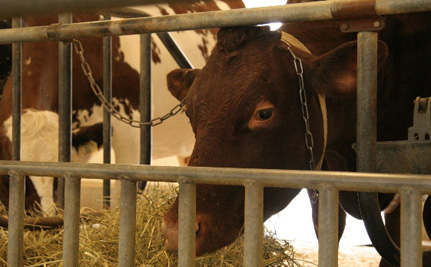
I recently discovered a fantastic article called ‘Vegetarian Is The New Prius‘, written by Kathy Freston, author of Quantum Wellness. Some may remember Kathy Freston from her appearances on Oprah and Ellen, where she made a substantial impact on the lives of both of these women. After interviewing Kathy on her Soul Series, Oprah was so moved by what she read in Quantum Wellness that she embarked on a 21-day cleanse diet, cutting out all animal products, alcohol, caffeine, refined sugars and gluten.
What moved Oprah to make such a radical shift in diet (albeit temporarily) was Freston’s way of explaining what it means to eat “consciously.” In her blog, Oprah described how deeply affected she was by Kathy’s descriptions of the harm we do to animals used for food. But the article I just read is not about animal welfare or the conditions under which farmed animals suffer at the hands of humans. It focuses instead on the 2007 UN report about the environmental impact of animal farming, and her short article makes a powerful case for the ecological imperative of transitioning towards a plant-based diet:
In 2007, the United Nations published a report on livestock and the environment with a stunning conclusion: ‘The livestock sector emerges as one of the top two or three most significant contributors to the most serious environmental problems, at every scale from local to global.’ It turns out that raising animals for food is a primary cause of land degradation, air pollution, water shortage, water pollution, loss of biodiversity, and not least of all, global warming.
According to the UN report, almost a fifth of global warming emissions come from livestock, which equals more emissions than come from all of the world’s transportation combined.
To someone who hasn’t heard these statistics before, it could be hard to imagine how this is true, until you become aware of the vast scale of the animal industry.
The United States alone slaughters more than 10 billion land animals every year… . Land animals raised for food make up a staggering 20% of the entire land animal biomass of the earth. We are eating our planet to death.
Then there is the fact that feeding animals for meat, dairy, and eggs requires around ten times as much grain as we’d need to feed the population a plant-based diet. When you add the environmental cost of transportation and refrigeration, it turns out that a calorie of meat protein requires ten times as much in the way of fossil fuels as a calorie of plant protein. On top of that, the production of that same calorie of protein releases more than ten times as much carbon dioxide.
The researchers found that, when it’s all added up, the average American does more to reduce global warming emissions by going vegetarian than by switching to a Prius.
Kathy Freston goes on to discuss the vast quantities of land required for animal farming.
Animal agriculture takes up an incredible 70% of all agricultural land, and 30% of the total land surface of the planet. As a result, farmed animals are probably the biggest cause of slashing and burning the world’s forests. Today, 70% of former Amazon rainforest is used for pastureland, and feed crops cover much of the remainder.
As the forests of the planet are designed to absorb carbon dioxide from the air, burning them not only destroys the very systems that are designed to process all the gases we are producing, but it also releases all the stored carbon dioxide, “in quantities that exceed by far the fossil fuel emission of animal agriculture.”
And of course, most people are aware now that as well as carbon dioxide, there are other greenhouse gases that are produced in large quantities by huge herds of farmed animals. According to Freston’s article, methane and nitrous oxide have “23 and 296 times the warming power of carbon dioxide, respectively… while animal agriculture accounts for 9% of our carbon dioxide emissions, it emits 37% of our methane, and a whopping 65% of our nitrous oxide.”
She goes on to explain how farming food animals is also one of the biggest causes of some of our other global environmental problems:
Animal agriculture accounts for most of the water consumed in this country, emits two-thirds of the world’s acid-rain-causing ammonia, and is the world’s largest source of water pollution–killing entire river and marine ecosystems, destroying coral reefs, and of course, making people sick.
All of these statistics seem to add up to one profound conclusion: We simply cannot go on like this. The ethical question of vegetarianism in regard to the animals who are the innocent victims of our eating habits has been debated for centuries, leading to a growing population of ethical vegetarians and vegans. Now there are other issues to be considered, issues which are extremely time-sensitive when it comes to the future of our planet and the human population.
It seems that we have created a situation for ourselves where, if we want to turn this global catastrophe around, we simply must re-examine our old ways of thinking, and the biggest thing we need to address is the way we eat. Fortunately, in today’s society, the options are plentiful, information is readily accessible and the choice is easier than it has ever been.
Originally published on Care2

saying such wrong thing like “Today, 70% of former Amazon rainforest is used for pastureland, and feed crops cover much of the remainder.” turns these interesting article into a waste of your time.
Comment by andre luft — May 7, 2009 @ 3:10 am |
Andre,
I’m not sure of the nature of your objection. If you have evidence that the statistic is untrue, please provide it.
My post quotes another article, by a well-reputed writer. If she is wrong, then I’d like to know.
Angel
Comment by Angel Flinn — May 7, 2009 @ 10:43 am |